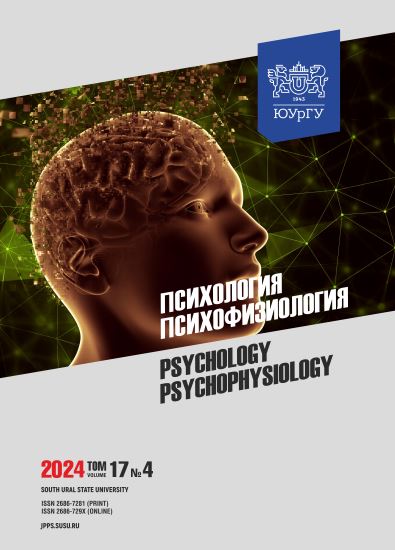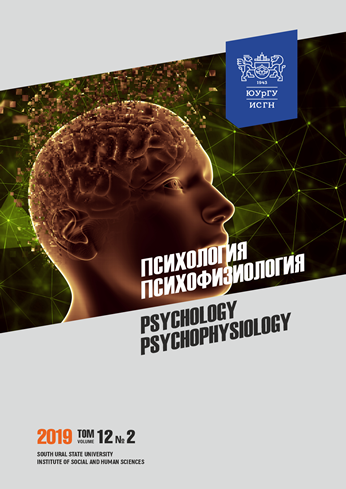Relationships between emotional intelligence and mental state in youth forum participants with different levels of social anxiety
Abstract
Introduction. Cost, ease of access, security measures, and the target audience determine successful events. Furthermore, this latter factor significantly influences the overall atmosphere and the nature of interactions. Aim: to identify the relationship between emotional intelligence and mental state in youth forum participants categorized by levels of social anxiety. Materials and methods. The sample consisted of 72 participants (59 females, 13 males) aged 33.1 ± 10.2 years attending the “Student Tourism UFA-2024” forum. The study promotes a mixed-methods approach, combining three primary assessment tools: the social anxiety and social phobia questionnaire, the EmIn questionnaire (short form), and the assessment of mental activation, interest, emotional tone, stress, and comfort methodology. Respondents were allocated into groups based on their scores on the “Social anxiety in situations involving being the center of attention” scale (medium, elevated, high severity). Statistical tests, including Shapiro–Wilk, Kruskall–Wallis, and Mann–Whitney, were conducted. Spearman's rank-order correlation analysis was applied. Results. Interpersonal emotional intelligence in individuals with average social anxiety levels shows negative correlations with rumination, emotional tone, interest, and contact avoidance. For individuals with increased social anxiety, emotional intelligence encompasses both interpersonal (managing others’ emotions) and intrapersonal (understanding one's emotions) components, associated mainly with social anxiety caused by contact avoidance. In the high social anxiety group, significant relationships between social anxiety and both EmIn components (intrapersonal and interpersonal) were observed. Emotion restraint and post-situational rumination are associated with intrapersonal emotional intelligence. Initiating action, resulting in fear of criticism and loss of personal control, is the predominant type of anxiety. This anxiety is exacerbated by positive correlations with parameters representing current mental state, including interest, emotional tone, and comfort. Conclusion. This study contributes to EI-based technologies targeting social anxiety in non-clinical populations.
Downloads
References
2. Little C. Undergraduate research as a student engagement springboard: Exploring the longer-term reported benefits of participation in a research conference. Educational Research. 2020;62(2):229–245. DOI: 10.1080/00131881.2020.1747360
3. Pull C.B. Current status of knowledge on public-speaking anxiety. Current Opinion in Psychiatry. 2012;25(1):32–38. DOI: 10.1097/YCO.0b013e32834e06dc
4. Vladykina I.K. Strakh publichnykh vystuplenii: sotsialno-psikhologicheskii analiz [Fear of public speaking: a socio-psychological analysis]. Politicheskaya psikhologiya: Khrestomatiya [Political psychology: A textbook]. Moscow. Aspect Press Publishing House, LLC. 2018:428–439. (in Russ.).
5. Mills S. Gender and Performance Anxiety at Academic Conferences. Ed. J. Baxter. Speaking Out. Palgrave Macmillan. London. 2006. DOI: 10.1057/9780230522435_4
6. Vyrskaya O.B. Manifestation of fear of public speaking depending on self-esteem and self-perception of personality. Business and society. 2023;1(37). URL: http://busines-society.ru/2023/1-37/22_vyrskaja.pdf (accessed: 15.16.2024) (in Russ.).
7. Lamprou E., Koupriza G., Vatakis A. The perception and passage of time during public speaking. Acta Psychologica. 2024;246:104268. DOI: 10.1016/j.actpsy.2024.104268
8. Matyukhin I.V. Investigation of the types and causes of the reaction of people speaking in public. Sovremennoe obrazovanie = Modern education. 2015;4:92–113. DOI: 10.7256/2409-8736.2015.4.16308 (in Russ.).
9. Harb G.C., Eng W., Zaider T., Heimberg R.G. Behavioral assessment of public-speaking anxiety using a modified version of the Social Performance Rating Scale. Behaviour Research and Therapy. 2003;41(11):1373–1380. DOI: 10.1016/S0005-7967(03)00158-X
10. Girondini M., Stefanova M., Pillan M., Gallace A. The Effect of Previous Exposure on Virtual Reality Induced Public Speaking Anxiety: A Physiological and Behavioral Study. Cyberpsychology, Behavior, and Social Networking. 2023;26(2):127–133. DOI: 10.1089/cyber.2022.0121
11. Tejwani V., Ha D., Isada C. Observations: Public Speaking Anxiety in Graduate Medical Education – A Matter of Interpersonal and Communication Skills? Journal of Graduate Medical Education. 2016;8(1):111. DOI: 10.4300/JGME-D-15-00500.1
12. Takac M., Collett J., Blom K.J. et al. Public speaking anxiety decreases within repeated virtual reality training sessions. PLoS One. 2019;14(5):e0216288. DOI: 10.1371/journal.pone.0216288
13. Hirsch C.R., Mathews A., Clark D.M. et al. The causal role of negative imagery in social anxiety: A test in confident public speakers. Journal of Behavior Therapy and Experimental Psychiatry. 2006;37(2):159–170. DOI: 10.1016/j.jbtep.2005.03.003.
14. Zeigarnik B.V. Mediation and self-regulation in norm and pathology. Vestnik Moskovskogo universiteta. Seriya “Psikhologiya” = Bulletin of the Moscow University. Series “Psychology”. 1981;2:9–15. (in Russ.).
15. Clark D.M., Wells A. A cognitive model of social phobia. Social phobia: Diagnosis, assessment, and treatment. Eds. R.G. Heimberg, M. Liebowitz, D. Hope, F. Schneier. New York. Guilford Press. 1995:69–93.
16. Kuai S.G., Liang Q., He Y.Y., Wu H.N. Higher anxiety rating does not mean poor speech performance: dissociation of the neural mechanisms of anticipation and delivery of public speaking. Brain Imaging and Behavior. 2021;15(4):1934–1943. DOI: 10.1007/s11682-020-00387-3
17. Krasnova V.V., Kholmogorova A.B. Social anxiety and its link to emotional maladjustment, stress level and quality of students interpersonal relations. Voprosy psikhologii. 2011;3:49–58. (in Russ.).
18. Summerfeldt L.J., Kloosterman P.H., Antony M.M., Parker J.D.A. Social anxiety, emotional intelligence, and interpersonal adjustment. Journal of Psychopathology and Behavioral Assessment. 2006;28:57–68
19. Xue S., Kong F., Song Y., Liu J. Neural correlates of social interaction anxiety and their relation to emotional intelligence: A resting-state fMRI study. Neuroscience Letters. 2024;818:137475. DOI: 10.1016/j.neulet.2023.137475
20. Sutterby S.R., Bedwell J.S., Passler J.S. et al. Social anxiety and social cognition: The influence of sex. Psychiatry Research. 2012;197(3):242–245. DOI: 10.1016/j.psychres.2012.02.014
21. Gan S.K., Zeng Y., Wang Z. Social anxiety mediates workplace incivility and work engagement. Frontiers in Psychology. 2023;14:1320703. DOI: 10.3389/fpsyg.2023.1320703
22. Gerhardt C., Semmer N. K., Sauter S. et al. How are social stressors at work related to well-being and health? A systematic review and meta-analysis. BMC Public Health. 2021;21:890. DOI: 10.1186/s12889-021-10894-7
23. Luneva P., Ababkov V. Coping behavior for social phobia. Vestnik Sankt-Peterburgskogo universiteta. Psikhologiya = Vestnik of Saint Petersburg University. Psychology, 2023;13(2):147–163. DOI: 10.21638/spbu16.2023.202 (in Russ.).
24. Cao J., Si F., Zhan Y. et al. Social anxiety modulates emotion processing for social threat words: Evidence from ERP. Neuroscience Letters. 2023;816:137498. DOI: 10.1016/j.neulet.2023.137498
25. Hofmann S.G. Cognitive factors that maintain social anxiety disorder: A comprehensive model and its treatment implications. Cognitive Behaviour Therapy. 2007;36:193–209. DOI: 10.1080/16506070701421313
26. Farmer A.S., Kashdan T.B. Social anxiety and emotion regulation in daily life: Spillover effects on positive and negative social events. Cognitive Behaviour Therapy. 2012;41:152–162. DOI: 10.1080/16506073.2012.666561
27. Gorbatkov A.A. Dynamics of emotions in activity: differential aspect. Psikhologicheskii zhurnal = Psychological Journal. 2007;28(4):101–113. (in Russ.).
28. Kravchenko Yu.E. Suppression of emotional behavior and subjective experience. Eksperimentalnaya psikhologiya = Experimental psychology. 2015;8(1):28–38. (in Russ.).
29. Sagalakova O.A., Truevtsev D.V. Questionnaire of social anxiety and social phobia. Med-itsinskaya psikhologiya v Rossii = Medical psychology in Russia. 2012;4(15). URL: http://mprj.ru/archiv_global/2012_4_15/nomer/nomer19.php (accessed: 08.05.2024). (in Russ.).
30. Pankratova A.A., Kornienko D.S., Lyusin D.V. Short form of the EMIN questionnaire. Psikhologiya. Zhurnal Vysshei shkoly ekonomiki = Psychology. Journal of the Higher School of Economics. 2022;19(4):822–834. DOI: 10.17323/1813-8918-2022-4-822-834
31. Summerfeldt L.J., Kloosterman P.H., Antony M.M., Parker J.D.A. Social anxiety, emotional intelligence, and interpersonal adjustment. Journal of Psychopathology and Behavioral Assessment. 2006;28:57–68. DOI: 10.1007/s10862-006-4542-1
32. Ilyin E.P. Emotsii i chuvstva [Emotions and feelings]. St. Petersburg: Peter. 2001:752.
(in Russ.).
33. Tsukanov S.S., Ornatskaya A.D. Approaches to understanding interest in the pedagogy of vocational education. Tendentsii razvitiya nauki i obrazovaniya = Trends in the development of science and education. 2020;65-3:101–103. DOI: 10.18411/lj-09-2020-105 (in Russ.).
34. Minyurova S.A., Brel E.Yu., Kruzhkova O.V. et al. The Nonlinearity of the Relationship between Emotional Intelligence and Anxiety of Teachers. Pedagogicheskoe obrazovanie v Rossii = Pedagogical Education in Russia. 2023;3:199–207. (in Russ.).
35. Huang L., Pricer L. How video conferencing promotes preferences for self-enhancement products. International Journal of Research in Marketing. 2024;41(1):93–112. DOI: 10.1016/j.ijresmar.2023.09.001.
36. Saint S.A., Moscovitch D.A. Effects of mask-wearing on social anxiety: an exploratory review. Anxiety, Stress, Coping. 2021;34(5):487–502. DOI: 10.1080/10615806.2021.1929936
37. Choi J.J., Kwak S.S. Who Is This?: Identity and Presence in Robot-Mediated Communication. Cognitive Systems Research. 2017;43:174–189. DOI: 10.1016/j.cogsys.2016.07.006
38. Gleason B., Greenhow C. Hybrid Education: The Potential of Teaching and Learning with Robot-Mediated Communication. Online Learning. 2017;21:159–176. DOI: 10.24059/olj.v21i4.1276
References on translit
-Copyright (c) 2024 Psychology. Psychophysiology

This work is licensed under a Creative Commons Attribution-NonCommercial-NoDerivatives 4.0 International License.



